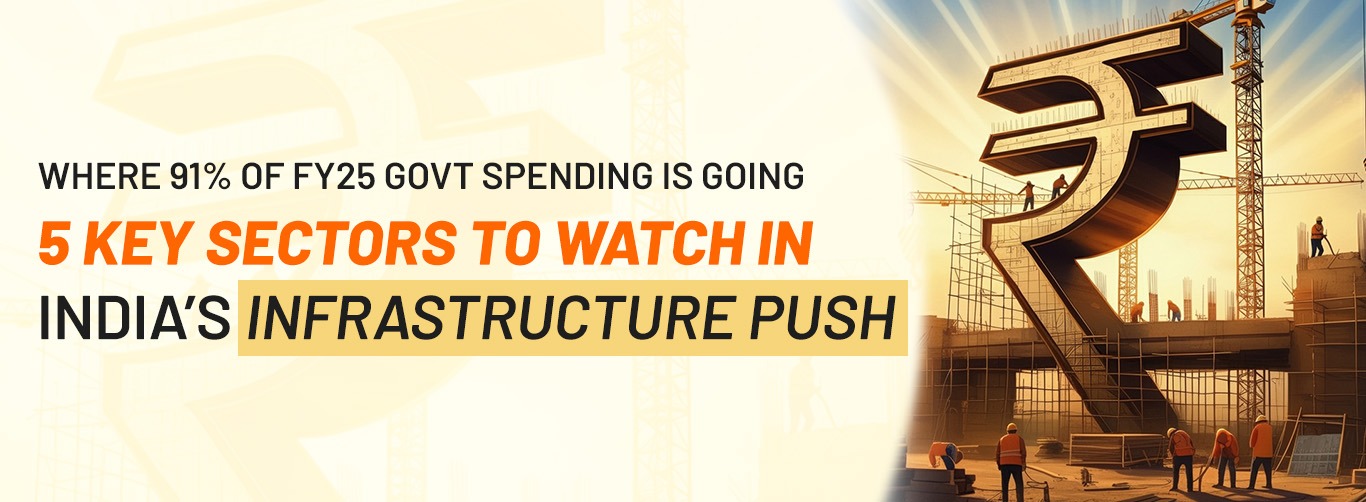As India gears up for a transformative infrastructure push, five core sectors are set to receive the lion’s share of central government investments in the financial year 2024–25. According to a recent research report by Bank of Baroda, a staggering ₹6.8 lakh crore, or nearly 91% of the total planned investment, is earmarked for just five strategic sectors: renewable electricity, road transport, refineries, conventional electricity, and shipping.
This concentrated allocation reflects the government’s continued focus on driving long-term economic growth through sustainable energy, robust connectivity, and industrial development.
1. Renewable Electricity: Powering the Green Shift
Leading the pack, renewable electricity has claimed the largest share of the investment—₹2.7 lakh crore, or 37% of the total. These projects are projected to add 12,555 megawatts (MW) of new green energy capacity.
This massive push underscores India’s commitment to accelerating its energy transition and reducing dependence on fossil fuels, in line with its climate goals. Solar and wind power are expected to dominate this segment, with several large-scale utility and hybrid projects already in the pipeline.
2. Road Transport: Building the Nation’s Backbone
The road transport sector continues to be a key pillar of India’s infrastructure agenda. With a significant portion of investment flowing into highway expansion and connectivity upgrades, the aim is to boost trade efficiency, ease logistics costs, and improve rural–urban mobility.
Although the exact breakdown for this sector wasn’t disclosed in the report, it remains one of the top destinations for capital expenditure.
3. Refineries: Fueling the Future
The government also plans to invest ₹1 lakh crore in the refinery sector, primarily through state-run enterprises. These investments are geared toward boosting domestic refining capacity and are expected to generate 600 MW of power, making them a hybrid model of industrial and energy output.
The move also supports India’s broader aim of becoming a self-reliant energy hub while meeting rising fuel demand.
4. Conventional Electricity: Powering Progress
Despite the strong tilt toward renewables, conventional electricity generation hasn’t been left behind. Around ₹99,376 crore will go toward traditional power projects. The bulk of this—₹80,000 crore—is concentrated in a single large-scale project in Bihar, with additional investments planned for Odisha and Chhattisgarh.
This balanced approach is likely aimed at ensuring energy reliability and meeting immediate power needs, especially in under-electrified regions.
5. Shipping: Coastal Infrastructure Gets a Lift
The shipping sector rounds out the top five, with projects worth ₹62,120 crore. Notably, Gujarat is set to receive ₹58,750 crore, making it the largest beneficiary. The remaining investments will support coastal infrastructure development in Assam, Karnataka, Kerala, and Tamil Nadu.
These investments aim to modernize ports, boost cargo handling, and enhance India’s global trade competitiveness.
What About the Rest?
The remaining 9% of the investment pie, still a significant amount, is distributed across other sectors such as:
- Chemicals and Steel
- Railways and Minerals
- Housing and Health
- Education and Fertilizers
- Electricity transmission and storage
While smaller in scale, these sectors remain essential to holistic development and social welfare.
Focus on Eastern India
The report also highlights a geographic shift in investment priorities, with Chhattisgarh set to receive the highest allocation at ₹1.4 lakh crore, followed by Odisha with ₹0.8 lakh crore. This signals a strategic intent to boost infrastructure and economic activity in eastern India, a region historically under-invested compared to its western and southern counterparts.
Bottom Line: A Decisive Infrastructure Play
The FY25 investment plan reflects the government’s focus on building long-term infrastructure that fuels growth, improves connectivity, and supports sustainability. With a clear tilt toward renewables and logistics, these five sectors are not only shaping India’s economic priorities but also laying the groundwork for its green and inclusive future.
As these projects unfold, they are likely to have a multiplier effect across industries, generating jobs, encouraging private investments, and boosting regional development.
Subscribe for more insights on India’s infrastructure and policy trends.
Disclaimer: This article is for informational purposes only and should not be considered as investment advice.

Leave a Reply